A quick walk-through

The Planning phase is the third phase of the IT Project Management Lifecycle. It begins after the project is initiated. In the Planning phase, various planning activities will be conducted, which includes the planning of work, schedule, budget, resources, staffing need, and etc. Those planning activities are performed to ensure the project will be completed on time and within budget. Project being planned progresses to the Execution and Control phase of the life cycle.
Activities and deliverables
The table below lists the major activities of this phase and the deliverables (i.e. process documents) output from the activities.
| Activity | Description | Deliverable |
|---|---|---|
| Conduct Planning Kick-off Meeting | Set expectations with the team by conducting a kick-off meeting with all the participants of this phase. | |
| Define Project Activities (Using WBS) | Define project activities using a Work Breakdown Structure. | Work Breakdown Structure |
| Schedule Activities | Identify the schedule of each work package and their inter-dependencies. | Project Schedule |
| Perform Resource Planning | Determine the type and amount of resources needed to complete the project. | Resource Plan |
| Perform Staffing Planning | Document the staffing plan, which ensures the appropriate human resources with the necessary skills are acquired. | Staffing Plan |
| Perform Budget Planning | Summarize the expenditures and source of funding for the project during the life of the project. | Budget Plan |
| Perform Project Performance Planning | Identify the performance goal for each of the business objective. | Project Performance Plan |
| Perform Risk Management Planning | Identify how risks can be identified, mitigated, managed and controlled. | Risk Management Plan |
| Identify and Record Project Risks | Identify project risks by following the risk management approach described under the Risk Management Plan. | Risk Register |
| Perform Change & Configuration Management Planning | Identify the project components that are governed by the change control process, and the documentation of change process. | Change & Configuration Management Plan |
| Perform Procurement Planning | Describe how the various aspects of procurement will be managed from the beginning to the end of the project. | Procurement Plan |
| Perform Communications Planning | Describe stakeholders' information needs and how the needs can be satisfied. | Communications Plan |
| Perform Quality Management & IV&V Planning | Plan product and project related quality assurance activities. | Quality & IV&V Plan |
| Develop Project Plan | Combine individual planning document into a Project Plan. | Project Plan |
Conduct Planning Kick-off Meeting
Before you start any actual planning, a kick-off meeting will be conducted with all the participants of this phase, to set expectations, articulate likely risks and clarify uncertainties the project team may have.
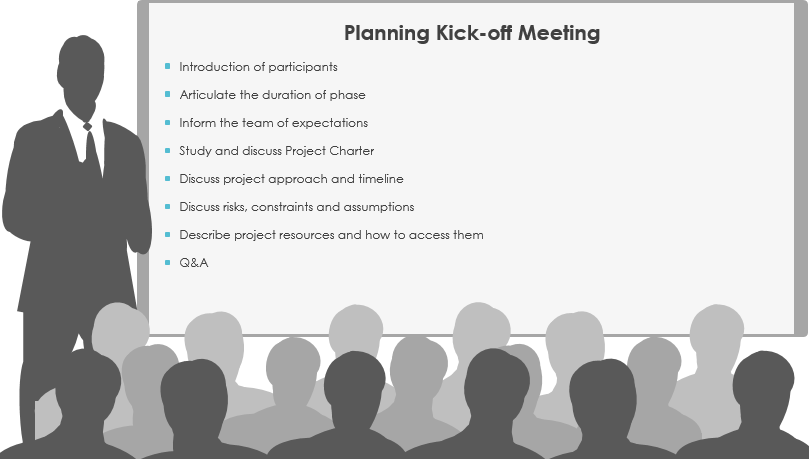
Here is the agenda items of a typical planning kick-off meeting.
- Introduction of participants: A brief introduction of the project team and the parties that are involved in the project. Describe their role and responsibilities in brief.
- Articulate the duration of phase: Make sure everyone is clear about the start and end date of the Planning phase
- Inform the team of expectations: Set the rules and guidelines for the planning phase. Inform the team of the expectations. For example, it's expected that Project Manager must be involved in any formal and informal meetings with stakeholders.
- Study and discuss Project Charter: Study and discuss the elements in the Project Charter. Make sure everyone is clear about the project vision, major milestones, and etc.
- Discuss project approach and timeline: Discuss the overall project approach and stress the importance of planning activities schedule. Depending on the length of this part and the need of non-project team stakeholder's involvement, this part can be split into a separate meeting.
- Discuss risks, constraints and assumptions: Discuss the likely risks identified and may happen in this phase, and let the team know about the resolution strategies. Let's say if it's a risk that severe weather condition may impact the progress of planning activities then the impact foreseeable at this point, as well as the job arrangement should be discussed. Besides risks, it is important to make sure all participants are clear about the constraints and assumptions of project planning.
- Describe project resources and how to access them: Discuss the resources and tools needed to complete this phase and this project. If necessary, let the team know about how these resources can be acquired.
- Q&A: Answer any questions that the participants may have.
Define Project Activities (Using WBS)
The first planning activity is to define project activities, using a Work Breakdown Structure. The purpose of this activity is to establish a common understanding of project scope.
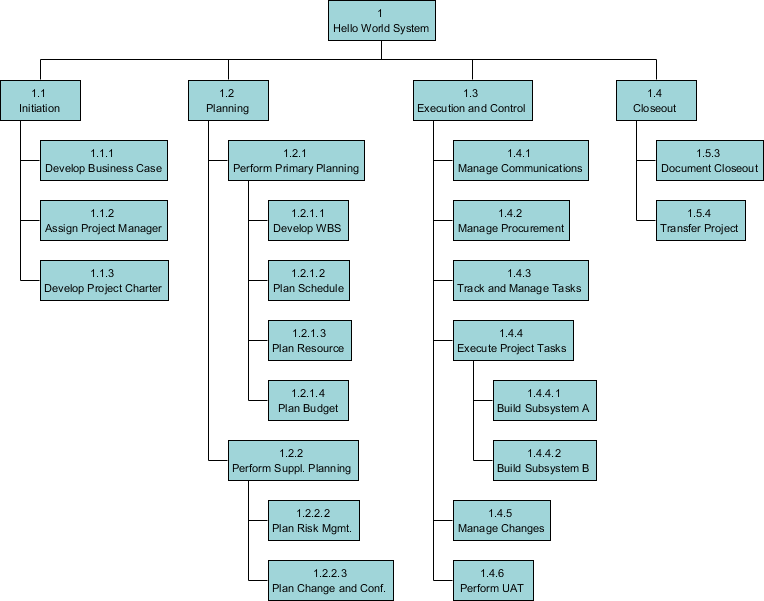
This is a sample work breakdown structure. It is a description of the work that must be done to complete the deliverables of a project. The root element is the context element, which is typically the name of the project. Each descending level in the WBS represents an increasingly detailed description of the project activities. The development of Work Breakdown Structure involves subdividing the major project activities or sub-activities into smaller, more manageable activities until the activities are defined in sufficient detail to support the management and development of project works. The items at the lowest level of a branch are known as work packages.
Generally speaking, there are three typical ways in structuring works with a Work Breakdown Structure (WBS). They includes phase-based structures, deliverable-based structures and responsibility-based structures, which defines the project activities based on the project phases, the deliverables agreed to deliver and the organization units that will work on the project, respectively.
Schedule Activities
The scheduling of activities involves identifying the schedule of each work package as identified in the previous activity and their inter-dependencies, using a PERT Chart. Project manager can use the schedule to plan and implement project tasks and to monitor the progress of the project.
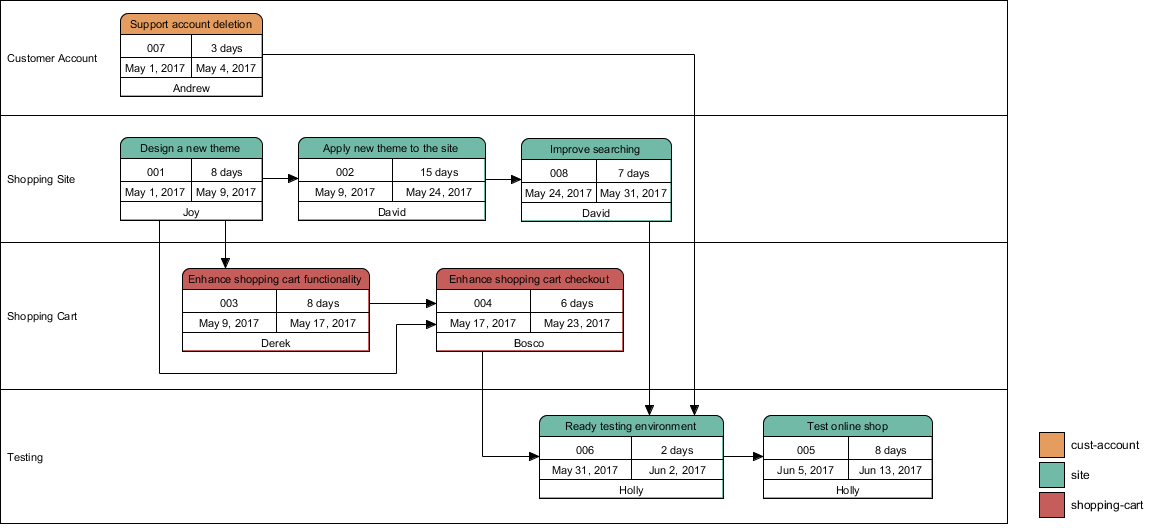
A PERT chart stands for Program Evaluation Review Technique, which helps you to create workflows, milestones, schedules, timetables, critical paths, and other planning requirements for a project. The connections between tasks represent their dependencies. Here are the properties of a PERT task:
- Name: The name of the task, which is the same as name of the corresponding work package.
- ID: Identifies the task uniquely.
- Planned start and finish date: The planning start and finish date of task. Note that a task can only be started if the depending task is completed. In other words the start date of a task must be greater than the finish date of all the depending tasks.
- Duration: The number of days between start and end date.
- Responsible Person: The person who are responsible for this task.
Perform Resource Planning
Resource planning involves determining the type and amount of resources needed to complete the project. An early estimation of resource needs was provided when developing the Project Charter in the Initiation phase. In this phase you have to provide a detailed breakdown of resources.
Typical resources may include material, facility, equipment and hardware, software, and etc. Staffing resources will be planned in the next activity so you may skip it here. For each of the identified resource, describe the following attributes:
- The amount and the quality needed. Say, if printer is a resource required, how many printers do you need? Is there any specific feature required? Such as color printing, print in double sides, etc.
- The status of allocation. Was the resource allocated? Was it reserved? Or just planned?
- The project activities that have such resource need.
- The time during which the resource will be consumed
- The planned date and time when the resource will be allocated
- The cost of purchasing or renting this resource
- Whether the cost is per hour, per day, per month or any other units
- The level of risk of not being able to acquire this resource as planned
Perform Staffing Planning
Staffing Plan is sometimes known as Human Resources Plan. The purpose of the Staffing Plan is to achieve project success by ensuring the appropriate human resources with the necessary skills are acquired.
Part of this activity involves identifying the roles and responsibilities of project stakeholders. Some of the project stakeholders were identified when developing the Project Charter. In this phase you have to include the roles for project team members. Programmer, quality manager and UX specialist are some typical project team member roles.
Once the stakeholder roles are identified, present their responsibilities as they relate to project tasks, using a RACI matrix. In the matrix, project stakeholders are listed as rows, while the work packages identified when developing the Work Breakdown Structure are listed as columns. You are required to mark the roles of different project roles. Here are the four kinds of roles and responsibilities:
- R means that a role is responsible for completing the work
- A stands for accountable. Stakeholders who take this role will ensure the completion and sign off of a task or its related documents
- C stands for consulted. Stakeholders who are consulted for decisions
- I stands for informed. Stakeholders who will be informed of any critical change or when an action or decision has been made
Perform Budget Planning
Budget planning involves summarizing the expenditures and source of funding for the project during the life of the project, by providing an expense or cost breakdown for each work package by fiscal year. Here is an example. The work package Conduct Planning Kick-off Meeting incurs a cost for Facility. And the cost in the first fiscal year is $300, so forth.
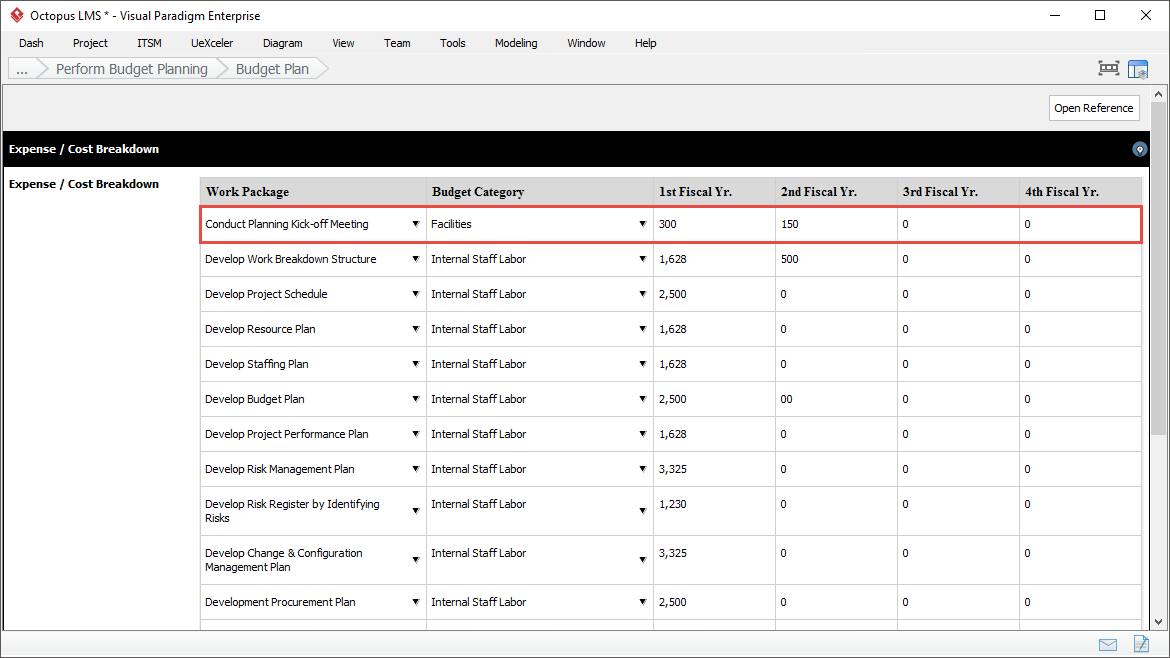
Perform Project Performance Planning
A set of business objectives have been defined in the Initiation phase, when developing the Project Charter. In this activity, have to identify the performance goal for each of them.
Performance goals are the performance standards to achieve. They help you know what is expected by the end user. An unclear, chaotic list of goals can lead a project to a failure. In project management the acronym SMART is used to assist people in thinking and validating performance goals. It represents five qualities your goals should have. They are:
- Specific - Good goals are well-written and focused.
- Measurable - There are concrete criteria for measuring progress of goal completion
- Attainable - Set realistic goals. Don't set goals that are too difficult to achieve or beyond the team's capabilities. If such a goal is proposed by the user and cannot be changed, you may need to assess the other part of the planning, such as the staffing plan, to see if the goal can be made attainable with more resource input
- Relevant - Make sure the goals are relevant to the business objective
- Time-Based - Sometimes called Time bound. Make sure a goal has a deadline defined.

The table below lists out some SMART performance goals examples, and why they are smart.
| Performance Goal | How SMART? |
|---|---|
| The shop page must be equally displayed in IE 9+, Firefox 40+, Chrome 50+ |
|
| Increase the average daily view count of the shop page by 20%. |
|
| Complete 'Add Item to Cart' by noon 13/8/2017 | It's Time-based, because a deadline is set. |
Besides setting performance goal, part of this activity involves detailing the acceptance criteria for each deliverable. In project charter a list of final deliverables have been identified. In this plan, you are required to specify the acceptance criteria for these deliverables, which will be used to determine or judge the completion of a deliverable.
Perform Risk Management Planning
Risks have negative impacts to a project. Therefore, it is important to take appropriate measures to identify, mitigate, manage and control them. Risk Management Planning is to identify and detail these aspects. Here are the risk management activities to be planned.
- Identification - Describe the process by which the risks will be identified. It should include the method(s) the project team will take to identify risks and the way and format in which risks will be recorded.
- Prioritization and Categorization - Explains how risks are qualified and prioritized. Once risks are identified it is important to evaluate the probability and impact of each risk in order to prioritize the risk and plan the mitigation strategy. Risks which are more likely to occur and have a significant impact on the project will be the highest priority risks
- Response Planning - Describe how the project team responses to each identified risk.
- Monitoring, Controlling and Reporting - Describe how the risks in the project will be monitored. It is important to ensure that risk monitoring is continuous throughout the lifecycle of the project and the trigger conditions for each risk are identified.
Identify and Record Project Risks
Identify project risks by following the risk management approach described under the Risk Management Plan. Information of each identified risk is stored in Risk Register.
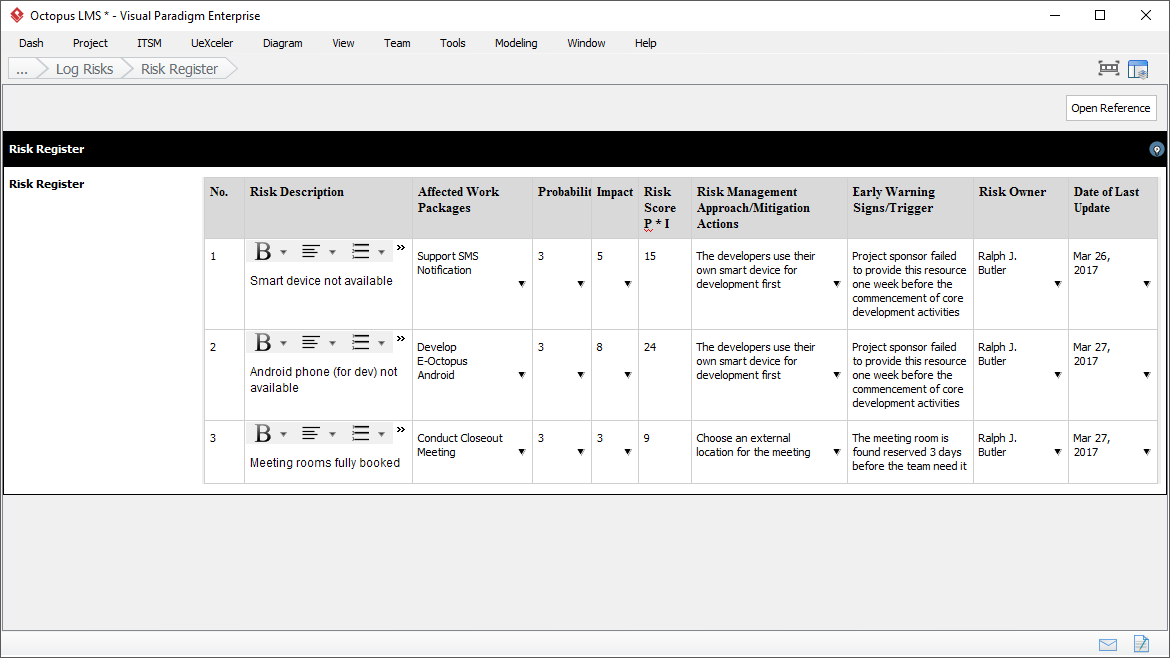
The Risk Register is a log of all identified risks. It shows the probability and impact of the risks to the project, mitigation strategy, and when the risk is estimated to occur. This Risk Register is created in the Planning phase of the project, and be updated in the Execution and Control phase with the risks identified during the execution of project activities. Here are the elements of risk register.
- Affected Work Packages: The work package elements that will be affected if the risk occurs.
- Probability: The likelihood that a risk or opportunity will occur, on a scale from 0 to 10 with 10 being the highest.
- Impact: The impact of the risk on the project if the risk occurs, scale from 0 to 10 with 10 being the highest.
- Risk Score: Determined by multiplying probability and impact.
- Risk Management Approach/Mitigation Actions: The action which is to be taken if this risk occurs.
- Early Warning Signs/Trigger: Something which indicates that a risk is about to occur or has already occurred.
- Risk Owner: The person who the project manager assigns to watch for triggers, and manage the risk response if the risk occurs.
- Date of Last Update: The date the particular log of risk was last reviewed and updated.
Perform Change & Configuration Management Planning
Change Management is an important part of project management. Changes must be vetted and managed to ensure that they are within the project scope and are communicated to all stakeholders. This activity involves the identification of project components that are governed by the change control process, and the documentation of change process.
There are two primary concepts in change and configuration management planning: Change control and configuration management control. Although they both are concerned with 'management of change', they are distinct activities and have different focuses. Here is a description of the two concepts:
- Change Control is the process of identifying, documenting, approving (or rejecting), and controlling changes to the change control items, which typically include the Scope, Schedule, Budget and Performance Plans. In other words, change control manages changes to the project baseline.
- Configuration Management Control is the process of managing the changes of the final project deliverables and related documents throughout the lifecycle of the project.
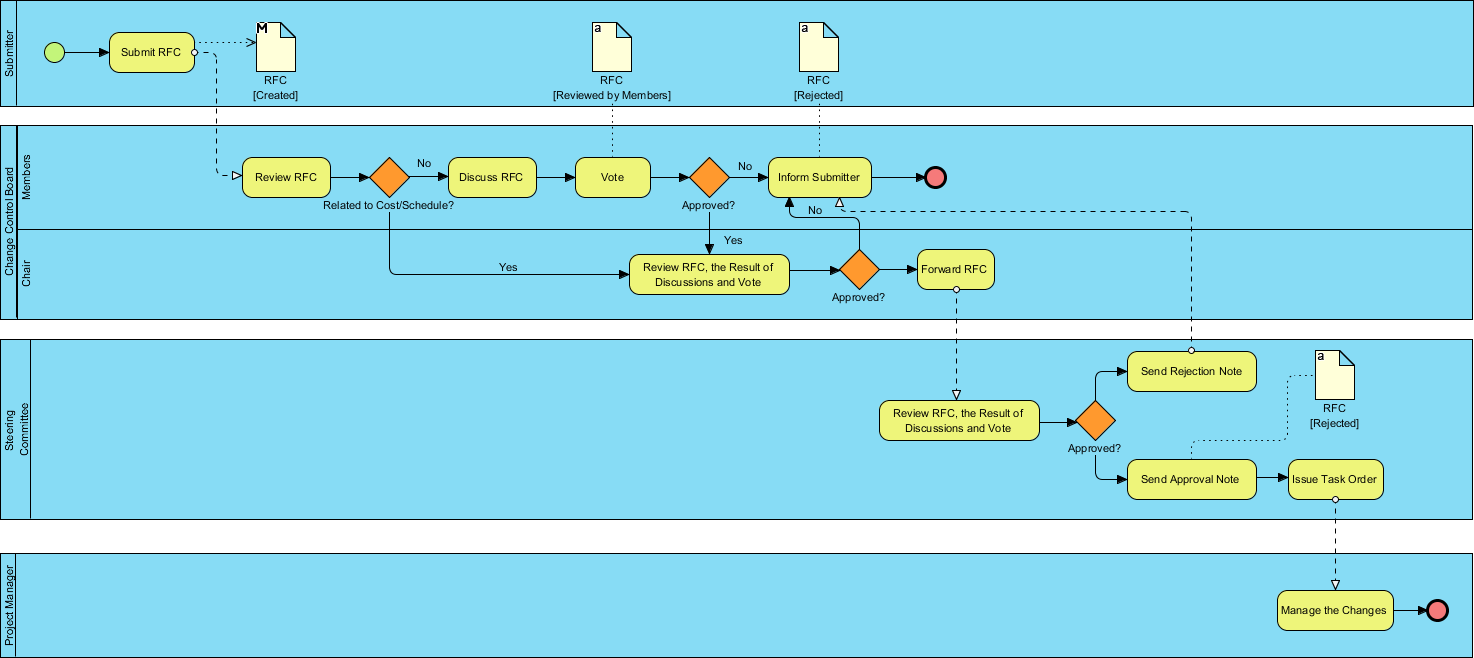
In short, change control focuses on project change, whereas configuration management control focuses on product change. Here is a business process diagram that visualizes the change control process. It starts from a change request submission, followed by a reviewing, discussion and voting process, and then approval, and finally ends by managing changes.
Perform Procurement Planning
Procurement planning involves identifying how project needs can best be fulfilled by procuring products and services outside. It involves describing how the various aspects of procurement will be managed from the beginning to the end of the project.
- Documentation Procedure: Describe how project procurement decision will be documented.
- Conduction of Procurement: Describe the necessary steps and responsibilities for procurement during the course of the project.
- Vendor Management: Describe the roles and actions the project team and purchasing and contracts department will take to ensure that the selected vendors provide all of the products and services agreed upon and that the appropriate levels of quality are maintained.
Perform Communications Planning
In project management, communication is the way to deliver information needed by someone. Different project stakeholders have different information needs. For example, the executive sponsor may want to know about how the project is going. It is important for communications to be performed smoothly so that the information can be delivered to stakeholders as needed.
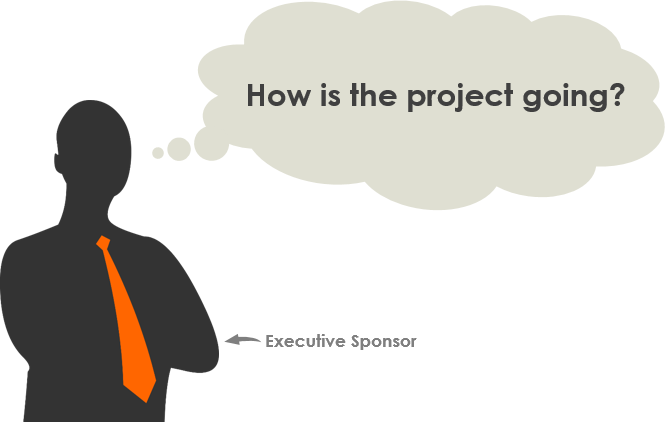
In order for the project members, customers and other stakeholders to have the information they need to achieve their duties, and to manage stakeholders' expectations about how the project is progressing, it is important to document the information needs and the way to deliver the information. It consists of three main steps
- Identify the information needs of stakeholders. Determine the people and target group that need to receive a particular kind of information. State their information needs
- Identify how information is reported. For each information need identified in step one, identify the purpose of such need, the provider of the information, when and how it is collected, and how the information will be reported
- Determine the delivery vehicle. For each report or document needed to communicate information, identify the methods for delivering the report or document. Typical examples include email, verbal, conference call, meeting, written memo, newsletter, website, formal presentation and status report. Specify the frequency of distribution for each report or document.
Perform Quality Management & IV&V Planning
This activity involves the planning of product and project related quality assurance activities. It's divided into three parts.
- Planning of product-related quality assurance activities. Define the in-process control plans, which address quality control areas
- Planning of project-related quality assurance activities. Determine how often the project plan will be reviewed to check for task slippage and any impact on dependencies.
- Planning of Independent Verification and Validation activities to be performed. The activities are described as "independent" because they will be performed by a disinterested third party.
Develop Project Plan
The project plan document is a combination of individual planning document obtained by performing the planning activities in this phase. Make sure the project plan document is approved by the approving authority in order to continue to the next phase.


